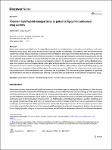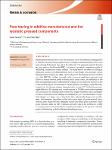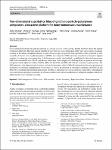Search
Author
- Osman, Ahmed I. (5)
- Daqing, Ma (3)
- Jorgensen, Ed (3)
- Li, Yan (3)
- next >
Subject
- kinh tế (26)
- Economics (12)
- programming (10)
- XRD (10)
- next >
Date issued
- 2020 - 2025 (2129)
- 2010 - 2019 (129)
- 2000 - 2009 (9)
- 1999 - 1999 (1)
Has File(s)
Search Results
Digitisation and Sharing of Collections: Museum Practices and Copyright During the COVID-19 Pandemic This article concerns the conflict between copyright and museums’ digitisation and online sharing of collections. This issue has recently become particularly important in connection with the COVID-19 pandemic. The authors outline the concept of a virtual museum and present the most important copyright provisions in EU law that may create obstacles for cultural institutions in realising virtual counterparts. To perceive copyright as the main obstacle in the process of digitisation and online sharing of collections is not unusual. Hence, the article briefly presents legal framework of the European copyright applicable to such situations. The authors argue that although copyright offers a range of possibilities for museums interested in digitising their collections, at the same time it... |
This article considers current advances in tattooing that are challenging community-held views of authorship and ownership, and the need to address this tension. The key challenge is from AI-generated artworks being used as tattoo designs, but the authorial role of the tattooist is also challenged by body art projects such as tattoo collection. Legal clarity for tattooing is lacking, and in addressing this, this article advocates for an open, community-based form of shared copyright ownership and authorship for projects as tattoo collecting, drawing on Dusollier’s and Mendis’ work. This article contributes to both copyright and cultural heritage legal scholarship, and to tattooing scholarship and the tattooing community. AI-generated art being tattooed on people has not been explore... |
Considering that culture is the product of creative and human processes, it is believed that intellectual property is a legal tool that allows for its protection given that it helps conserve, safeguard and preserve its tangible and/or intangible assets. In the case of digital heritage, which is made up of digital elements that should be preserved due to their cultural value, some challenges have arisen regarding their legal protection. One of these challenges is the lack of clarity about how the elements that comprise it should be protected, giving rise to doubts about how intellectual property should help solve this conflict. This article presents the discussion regarding the protection of digital heritage in Colombia, how copyright is becoming an instrument that contributes to its... |
Nanocarrier systems are widely used for drug delivery applications, but limitations such as the use of synthetic surfactants, leakage of toxic drugs, and a poor encapsulation capacity remain as challenges. We present a new hybrid nanocarrier system that utilizes natural materials to overcome these limitations and improve the safety and efficacy of drug delivery. The system comprises a biopolymeric shell and a lipid core, encapsulating the lipophilic anticancer drug paclitaxel. Bovine serum albumin and dextran, in various molecular weights, are covalently conjugated via Maillard reaction to form the shell which serves as a stabilizer to maintain nanoparticle integrity. The properties of the system, such as Maillard conjugate concentration, protein/polysaccharide molar ratio, and poly... |
The Coronavirus Disease (COVID-19) pandemic has brought significant impact onto the maritime activities worldwide, including disruption to global trade and supply chains. The ability to predict the evolution and duration of a COVID-19 outbreak on cargo vessels would inform a more nuanced response to the event and provide a more precise return-to-trade date. This paper presents the SEIQ(H)R (Susceptibility–Exposed–Infected–Quarantine–(Hospitalisation)–Removed/Recovered) model, which is the first deterministic mathematical model developed and fit-tested to describe the transmission dynamics of COVID-19 on board cargo vessels of up to 60 crew members. Due to specific living and working circumstances on board cargo vessels, instead of utilising the reproduction number, we consider the h... |
The recent bailout of Credit Suisse is noteworthy for many reasons. One of them is that, while AT1 bondholders were wiped out, shareholders were not. This violates the ‘absolute priority rule’ which is central to corporate reorganisation and bank resolution regimes. In this article, we analyse the motives and mechanics of the write-down and argue that, given the bond terms, the prospect for a legal challenge by the bondholders is slim. At the same time, we question the merits of the write-down. Bondholders should fare no worse than common equity, regardless of whether a financial institution is put in an insolvency proceeding or bailed out, and the applicable bond terms should reflect this. We also raise the issue of a more principled approach to bailouts more generally. |
Despite past scientific efforts and the increased use of hot isostatic pressing (HIP) in additive manufacturing applications, a complete understanding of the exact pore-closing behaviour has yet to be achieved. The present research focuses on laser powder bed fused (LPBF), hot isostatic pressed components made of AlSi10Mg, and process-related defects. The study shows the effect of HIPing in relation to various pore characteristics, such as pore shape, size, and type. A pore tracing method using X-ray data was developed to characterise the pores before and after HIP. The method is based on the k-nearest neighbours approach and allows to match leftover pores with the initial ones. Hence, the efficiency of the pore-closing behaviour for different HIP settings can be analysed. Moreover,... |
A situation of insolvency hinders a firm’s ability to obtain external finance. As a result, viable but financially distressed firms might be unable to keep operating and pursuing value-creating investment projects. Consequently, value can be destroyed for debtors, creditors, employees, suppliers and society as a whole. To address this problem, several jurisdictions around the world have adopted a system of rescue or debtor-in-possession (‘DIP’) financing that seeks to encourage lenders to extend credit to viable but financially distressed firms. They do so by providing DIP lenders with different forms of priority that typically range from a basic administrative expense priority to the possibility of becoming a junior or, in some jurisdictions, even a senior secured creditor. After a... |
Osseo-integration between the implant and bone is a crucial factor to create a strong, durable bond that allows the implant to function effectively. However, regular implant surface with poor osseo-integration ability may cause aseptic loosening, resulting in the failure of implants. Herein, a serial of macroscopic one-particle thick superlattice films generated by self-assembly of diverse size of gold nanoparticles (GNPs) were termed as SFGs and were considered as bioactive implant coatings for enhancing osseo-integration. A hydroquinone-assisted seed method is established to fabricate homogenous GNPs with controllable sizes (20, 60, and 90 nm), which were further employed as building blocks to generate macroscopic one-particle thick superlattice films of GNPs (SFGs-20, SFGs-60, an... |
The paper deals with the problem of digital restitution of art to post-colonial and postdependency countries. A new model of digital restitution composed of two elements: creation of a digital copy with a NFT attached and creation of new property right in a physical and digital object has been proposed. A system of balances between the rights and duties based on the prior user concept has been developed. |










